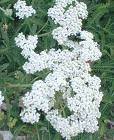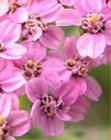Scientific Classification:
|
Other Common Names:
The other common names for this herb yarrow are Milfoil, Old Man's Pepper, Soldier's Woundwort, Knight's Milfoil,Herbe Militaris,Thousand Weed, Nose Bleed, Carpenter's Weed,Bloodwort,Staunchweed,Sanguinary,Devil's Nettle, Devil's Plaything, Bad Man's Plaything,Yarroway,Gandana,I-chi-kao,Millefoil,Noble Yarrow,Nosebleed,Stanchgrass,Thousand-leaf and thousand-seal.
History


Description



Range
Yarrow was introduced into the United States from Europe as an ornamental and medicinal plant. However, a Western form of this species that is smaller in size and woollier in appearance may be native to North America. Thus it is widely distributed in Europe, Asia and North America.Habitat
The plant can be found flourishing in waste lands, countryside, meadows, pastures, edges of the railway tracks, along the highways and in many other places where it is most unlikely to be plucked primarily owing to the chemical spraying done in those areas to keep the weeds out.Cultivation
Yarrow is propagated through its roots. Grow yarrow plants in full sun and in well-drained soil. It is drought-tolerant once established.pH preference is acidic to slightly alkaline. Common yarrow is a drought tolerant species of which there are several different ornamental cultivars. Seeds require light for germination, so optimal germination occurs when planted no deeper than ¼ inch. Seeds also require a germination temperature of 18-24 °C (65-75 °F). Common yarrow responds best to soil that is poorly developed and well drained. The plant has a relatively short life, but may be prolonged by dividing the plant every other year, and planting 12 to 18 inches apart. Common yarrow is a weedy species and can become invasive. It may suffer from mildew or root rot if not planted in well-drained soil. The aerial parts of the plant are plucked during summer when it is in blossom.Flowering Season
The white pale liliac flowers of the yarrow are in bloom between the months of June to September.Pests and Diseases
The common pests seen are the aphids but the plant usually shows no effects from these pests.Powdery Mildew, Root and stem rot and rust are the diseases attacking the yarrow plant.
Parts Used
Dried aerial parts and the essential oil of the plant are used for its medicinal and commercial applications.
Medicinal Applications

- An ointment of the leaves cures wounds and is good for inflammations and applied to ulcers and fistulas.
- A decoction of it boiled with white wine is good to stop the running of the reins in men and whites in women.
- It also contains a substance which hastens the clotting time of the blood following injury.
- It regulates menstruation, reduces blood pressure and heals bleeding piles.
- Yarrow is one of the best-known herbal remedies for fevers, common cold, influenza and helps the body expels toxins.
- It opens the pores freely and purifies the blood, and is recommended in the early stages of children's colds, and in measles and other eruptive diseases.
- A decoction of the whole plant is employed for bleeding piles, and is good for kidney disorders.
- It has the reputation also of being a preventative of baldness, if the head be washed with it.
- When taken internally, yarrow invigorates appetite, increases digestion as well as absorption of nutrients by the body.
- The astringent feature of yarrow makes it a useful medication in stopping diarrhea and dysentery as well as impedes hemorrhage from the intestinal coatings.
- It helps in healing infections and swollen organs like in the case of gastritis and enteritis.
- Yarrow helps in relieving cramps arising out of tensions, wind, colic or nervous dyspepsia.
- The herb is also useful in lowering blood pressure.
- The herb is useful in soothing painful joints and also clears the skin.
- The herb contains sterols, which have actions similar to hormones and aids in controlling the menstrual cycle and as well as heals uterus blockages.
- Yarrow is also useful as an herbal cleanser for skin wrinkles.
Commercial Applications
- It is used as an ingredient in salads. Yarrow has also been used as a food, and was very popular as a vegetable in the 17th century. The younger leaves are said to be a pleasant leaf vegetable when cooked as spinach, or in a soup.
- In the middle Ages, Yarrow was part of an herbal mixture known as gruit used in the flavouring of beer prior to the use of hops.
Religious Influences
Yarrow stalks are still used by the Chinese for casting I Ching predictions.Folklore and Myths
It was one of the herbs dedicated to the Evil One, in earlier days, being sometimes known as Devil's Nettle, Devil's Plaything, Bad Man's Plaything, and was used for divination in spells. It is believed that an ounce of Yarrow sewed up in flannel and placed under the pillow before going to bed, having repeated the following words, brought a vision of the future husband or wife. The yarrow stalk is famous for its use in the revered Chinese divination system called I Ching or Book of Changes. In Europe, ancient astrologers assigned the entire plant to the war-god Mars and its golden flowers thereby gained a reputation for imparting to the bearer Exceptional Bravery and protection from wounds and curses. People versed in these matters tell us that if you write your fears on a piece of paper, cross the fears with your name written 9 times, and carry the paper in a yellow conjure bag with yarrow flowers, you will overcome your fears through courage, personal mastery, and luck. 

